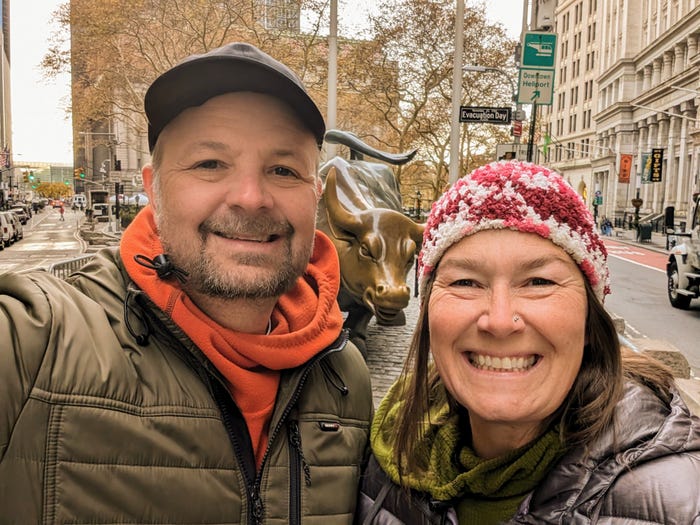A couple that grew their portfolio by $4 million in 11 years explain how they invest their money, including the individual stocks they own
6 min readA couple that grew their portfolio by $4 million in 11 years explain how they invest their money, including the individual stocks they own

- When Carl and Mindy Jensen discovered the FIRE movement, they changed their investing strategy.
- They had a lot of their money in individual stocks but started investing in index funds and ETFs.
- Their strategy, which also includes real estate, helped them grow their net worth to $5 million.
For most of his career, Carl Jensen planned on retiring in his 60s.
Then, in his early 40s, he discovered the Financial Independence, Retire Early (FIRE) community through blogs like “Get Rich Slowly” and “Mr. Money Mustache.”
There was another path — one that involved leaving the corporate world decades before the average retirement age — and he was hooked.
In 2013, at age 43, he set the goal of building a $1 million portfolio and retiring in 1,500 days. He started his own blog, “1500 Days to Freedom,” to document his and his wife Mindy’s journey.
The Jensens weren’t completely starting from scratch in 2013. They’d been smart with their money, Carl had maxed out his 401(k) every year, and they’d made money flipping homes. At the time, between individual stocks they owned and retirement accounts, they said they had about half a million dollars in investments.
With a specific early retirement goal in mind, however, they revamped their investment strategy — and they started seeing results. Their investments surpassed seven figures for the first time in 2016, they said.
In April 2017, Carl quit his software engineering job.
He and Mindy, who works part-time as a podcast host for BiggerPockets, have grown their investment portfolio from $586,000 in 2013 to $4.6 million in 2024. Their net worth, including their investments and primary home, sits just above $5 million, according to screenshots detailing their investment accounts viewed by Business Insider.
The couple, who are in their early 50s and reside in Longmont, Colorado, walked BI through their current investment portfolio and explained how their strategy has evolved over the last 11 years.
Individual stocks
The Jensens have nearly $2 million invested in individual stocks. They mainly own tech stocks, including Tesla (TSLA), Meta (META), Amazon (AMZN), and Google (GOOG), that they bought in the early 2010s before they started their FIRE journey and learned that there were other ways to invest your money besides stock picking. They share all of the stocks and funds they own on their blog.
While individual stocks make up the biggest chunk (about 42%) of their portfolio, that doesn’t reflect their current investment strategy or philosophy, which centers on index-fund investing.
“I don’t want us holding individual stocks to be portrayed as some amazing way to grow wealth because we could have just as easily invested in something that went to nothing,” said Mindy. “But, for the most part, we have done very well with our individual stocks because Carl has done so much research. He worked in tech, knew these companies, and believed in their mission and vision.”
Index funds and ETFs
About 20% of their portfolio is in index funds, including the Vanguard 500 Index Fund Admiral Shares Fund (VFIAX), the Vanguard Information Technology Index Fund ETF (ETF, VGT), and the Fidelity MSCI Information Technology Index ETF (ETF, FTEC).
Index fund investing is “the right answer for almost everyone, including ourselves,” said Carl. They would have invested in these types of funds, which are diverse by nature and tend to be low-cost, sooner, but they didn’t know about them until they discovered the FIRE movement.
“We’re slowly pivoting everything,” he added. “Almost all of our new money goes to index funds at this point in our life.”
Real estate
The Jensens have experimented with various real-estate investing strategies. They’re in the process of finishing their eighth “live-in flip,” in which they buy a house, rehab it while living there, and then resell it.
It eliminates some of the risk that comes with flipping a property.
“The beauty of this strategy is you need a place to live,” explained Carl. “You’d be in a much riskier situation if you had bought a separate house that you need to flip as soon as possible because you’re just pouring money into it, whereas we’re just paying the mortgage on our primary house, and it happens to be a construction zone, too.” That’s the big sacrifice you’re making. “This is a pretty rough way to live.”
They’re generally shifting away from flipping.
“We always have our eye on the real estate market,” said Mindy, who’s also a real-estate agent and has access to the MLS. “I’m always on the lookout for the next great deal, but we don’t have any plans for another live-in flip because we’re getting older, and it’s a lot of work.”
They’re starting to do more private lending. Issuing loans is much more passive than flipping homes and earns them about 12%.
“The private lending generates such a nice return that it’s difficult to be like, ‘No, we don’t want to have the easy money. Let’s go do another live-in flip,'” said Mindy. “But we’re also in a much different financial position now than we were when we started live-in flipping, and I think that’s important to note: You could still make money live-in flipping, and if you have more time than money, it can be a really great way to turn your home into an investment.”
The Jensens have also done syndication deals, in which a group of investors pool together their capital to purchase a single property managed by the syndicator.
It’s a completely passive investment — they simply provide a portion of the capital needed to buy the property — but it’s hard to know what your returns will look like, said Carl: “The thing I’ve found with all these is the people running these syndications will tell you they’re expecting numbers, and it’s infrequently accurate.”
That said, “every syndication we’ve had has actually outperformed the original numbers,” he added. “But none of them have outperformed an index fund.”
They’re in two syndication deals. These deals typically have a timeline between two and 10 years, though the average period for the Jensens has been about three years. While they’re open to reading pitch decks that come through, “we’re not currently looking to put more money into syndications because of the interest rate environment that we find ourselves in right now,” said Mindy.
Investment real estate makes up about 32% of their portfolio, and their primary home equity makes up another 8%.
Cash and other investments
They keep a small amount of money in cash, about $3,000. They also invested in a local distillery owned by one of their friends.
The Jensens recognize that investing is deeply personal and typically recommend J.L. Collins’ book, “The Simple Path to Wealth,” as an introduction to investing basics.
As for general investing advice, “If they want to be completely passive, they should do index funds,” said Carl. “But you can make more money with real estate if you’re willing to put the work in.”
If you don’t have the time to study your market and home in on a strategy, real estate may not be the best investment for you: “There’s a lot of knowledge that goes into doing these things successfully. We meet people all the time who have long-term rentals, they’re barely cash-flowing, and they would have done much better and had fewer headaches in life if they just would have put it in an index fund.
“So I would say the default is an index fund, but then perhaps real estate if you want to be more hands-on, are willing to put the time in, and have the time to do it, too.”
Discover more from Slow Travel News
Subscribe to get the latest posts sent to your email.



